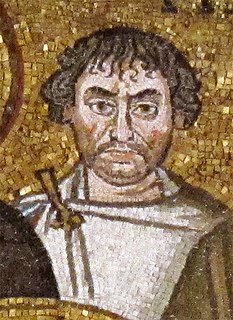 W
WAndronikos III Palaiologos, commonly Latinized as Andronicus III Palaeologus, was the Byzantine emperor from 1328 to 1341. Born Andronikos Doukas Angelos Komnenos Palaiologos, he was the son of Michael IX Palaiologos and Rita of Armenia. He was proclaimed co-emperor in his youth, before 1313, and in April 1321 he rebelled in opposition to his grandfather, Andronikos II Palaiologos. He was formally crowned co-emperor in February 1325, before ousting his grandfather outright and becoming sole emperor on 24 May 1328.
 W
WArtavasdos or Artabasdos, Latinized as Artabasdus, was a Byzantine general of Armenian descent who seized the throne from June 741 or 742 until November 743. His reign constitutes a usurpation against Constantine V, who had retained control of several themes in Asia Minor.
 W
WSymbatios, variously also Sabbatios (Σαββάτιος) or Sambates (Σαμβάτης) in some sources, was the eldest son of the Byzantine emperor Leo V the Armenian. Soon after the coronation of his father, he was crowned co-emperor and renamed Constantine. He reigned nominally along with his father until the latter's deposition in 820, after which he was exiled to Prote, one of the Princes Islands, as a monk.
 W
WHeraclius the Elder was a Byzantine general and the father of Byzantine emperor Heraclius. Of possible Armenian origin, Heraclius the Elder distinguished himself in the war against the Sassanid Persians in the 580s. As a subordinate general, Heraclius served under the command of Philippicus during the Battle of Solachon and possibly served under Comentiolus during the Battle of Sisarbanon. In circa 595, Heraclius the Elder is mentioned as a magister militum per Armeniam sent by Emperor Maurice to quell an Armenian rebellion led by Samuel Vahewuni and Atat Khorkhoruni. In circa 600, he was appointed as the Exarch of Africa and in 608, Heraclius the Elder rebelled with his son against the usurper Phocas. Using North Africa as a base, the younger Heraclius managed to overthrow Phocas, beginning the Heraclian dynasty, which would rule Byzantium for a century. Heraclius the Elder died soon after receiving news of his son's accession to the Byzantine throne.
 W
WIsaac the Armenian was an exarch of Ravenna hailing from the Kamsarakan clan. The chronology of the Exarchate in this period is uncertain: either he succeeded Euselnus and served c. 625 – 644; or he succeeded Eleutherius, and served 620 – 637.
 W
WJohn VII, surnamed Grammatikos or Grammaticus, i.e., "the Grammarian", was Ecumenical Patriarch of Constantinople from January 21, 837 to March 4, 843, died before 867. He is not to be confused with the much earlier philosopher John Philoponos.
 W
WLeo V the Armenian was Emperor of the Byzantine Empire from 813 to 820. A senior general, he forced his predecessor, Michael I Rangabe, to abdicate and assumed the throne. He ended the decade-long war with the Bulgars, and initiated the second period of Byzantine Iconoclasm. He was assassinated by supporters of Michael the Amorian, one of his most trusted generals, who succeeded him on the throne.
 W
WMaurice was Byzantine emperor from 582 to 602. A prominent general, Maurice fought with success against the Sasanian Empire. After he became Emperor, he brought the war with Sasanian Persia to a victorious conclusion. Under him the Empire's eastern border in the South Caucasus was vastly expanded and, for the first time in nearly two centuries, the Romans were no longer obliged to pay the Persians thousands of pounds of gold annually for peace.
 W
WNarses was, with Belisarius, one of the great generals in the service of the Byzantine Emperor Justinian I during the Roman reconquest that took place during Justinian's reign. Narses was a Romanized Armenian. He spent most of his life as an important eunuch in the palace of the emperors in Constantinople.
 W
WGregory Pakourianos was a Byzantine politician and military commander. He was the founder of the Monastery of the Mother of God Petritzonitissa in Bachkovo and author of its typikon. The monks of this Orthodox monastery were Iberians.
 W
WRomanos IV Diogenes, also known as Romanus IV, was a member of the Byzantine military aristocracy who, after his marriage to the widowed empress Eudokia Makrembolitissa, was crowned Byzantine Emperor and reigned from 1068 to 1071. During his reign he was determined to halt the decline of the Byzantine military and to stop Turkish incursions into the Byzantine Empire, but in 1071 he was captured and his army routed at the Battle of Manzikert. While still captive he was overthrown in a palace coup, and when released he was quickly defeated and detained by members of the Doukas family. In 1072, he was blinded and sent to a monastery, where he died of his wounds.
 W
WAshot Taronites was a Byzantine nobleman. Captured by the Bulgarians in 995, he was released in 996 and married to Miroslava, daughter of Tsar Samuel of Bulgaria. Appointed governor of Dyrrhachium by Samuel, he and his wife fled to Constantinople and arranged for Dyrrhachium to be handed over to Byzantine rule.
 W
WGregory Taronites was an Armenian prince of Taron, who went over to Byzantine service and held senior commands and governorships under Emperor Basil II. He was killed by the Bulgarians at an ambush near Thessalonica ca. 991 or 995.
 W
WTheodora was a Byzantine empress as the spouse of the Byzantine emperor Theophilos, and regent of her son, Michael III, from Theophilos' death in 842 to 855. For her restoration of the veneration of icons, which ended the Byzantine Iconoclasm, she is venerated as a saint in the Eastern Orthodox Church; her Feast Day is 11 February. Several churches hold her as their patron saint.
 W
WThoros was an Armenian ruler of Edessa at the time of the First Crusade. Thoros was a former officer (curopalates) in the Byzantine Empire and a lieutenant of Philaretos Brachamios. He was Armenian but practiced the Greek Orthodox faith.